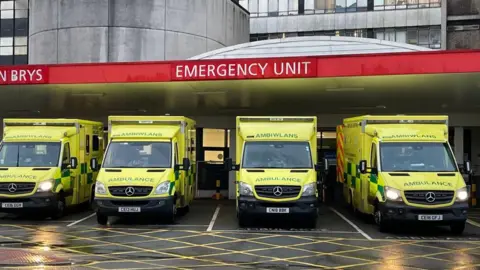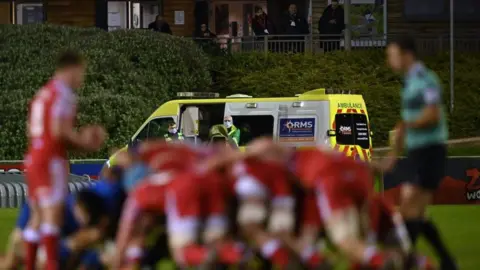New 'orange' ambulance category for stroke victims
 Getty Images
Getty ImagesA new "orange" category for ambulance 999 calls will be introduced in Wales, with the aim of speeding up and improving care for patients with strokes.
Those suffering strokes or a type of heart attack known as STEMI are currently in a broad "amber" category covering about 70% of all ambulance 999 calls.
Under the new approach specialist nurses and paramedics will screen calls to identify patients who need a rapid response and specialist care from paramedics before being taken to hospital.
Health Secretary Jeremy Miles said this would allow stroke patients to receive "the rapid, tailored response they need to survive, recover and thrive".
Although no time target will be attached to the new orange category - which will be introduced this winter - the average and longest response times will be recorded.
The type of care patients receive before arriving at hospital will also be monitored.
"For people in stroke, every minute counts if lives are to be saved and disability reduced or prevented," Miles said, adding "around two million brain cells are lost" for each minute that passes.
"That's why we're introducing a new orange category into the system which will help our ambulance service identify time-sensitive complaints such as stroke quickly and get patients the right specialist treatment faster."
Along with orange, the other categories taking amber's place will be yellow, for conditions which require further clinical assessment to determine the best course of action, and green, for conditions such as blocked catheters which may need community care or planned transport to urgent services.
The moves follow changes earlier this month to how most life-threatening 999 calls are categorised and colour-coded.
A "purple" category was introduced for people in cardiac or respiratory arrest, and a "red emergency" category for major trauma or other very serious incidents.
For these calls ambulances are expected to arrive in an average of six to eight minutes.
 Getty Images
Getty ImagesAlongside the call-category changes a new "video triage" scheme for suspected stroke patients is also being piloted in five areas.
This allows paramedics to communicate in real time with hospital stroke specialists before a patient arrives.
Andy Swinburn, executive director of paramedicine at the Welsh Ambulance Service, welcomed the changes.
"The nature of how patients present to 999 has changed and it's important to reflect this in the way we respond.
"First and foremost to increase ambulance availability for those who truly need it but also to ensure that patients who can be cared for closer to home get that opportunity."
Dr Shakeel Ahmad, national clinical lead for stroke in Wales, said when a patient is having a stroke "urgent rapid treatment is critical as every second counts in order to restore blood flow to the brain".
He added the new orange category would help "prioritise stroke patients who require this urgent treatment".
The changes are taking place against a backdrop of deteriorating ambulance response times over a number of years.
In January 2020 the average response time for amber calls stood at about 35 minutes, which had risen to almost 150 minutes by January 2025.
Last month, the outgoing boss of the ambulance service said hundreds of patients each month come to avoidable harm because ambulances were forced to wait outside crowded accident and emergency departments.
Jason Killens said so-called "handover delays", which have increased four-fold during his nearly seven years in charge, were "unsustainable and unacceptable".
